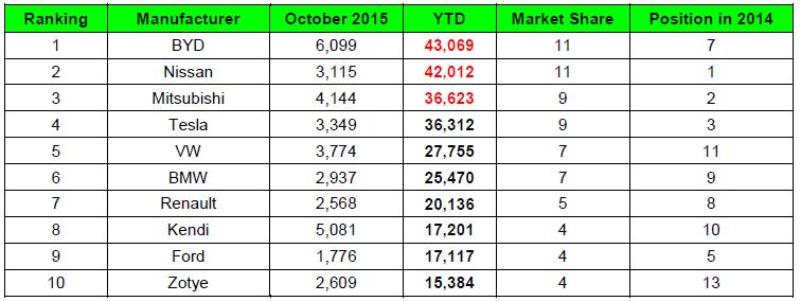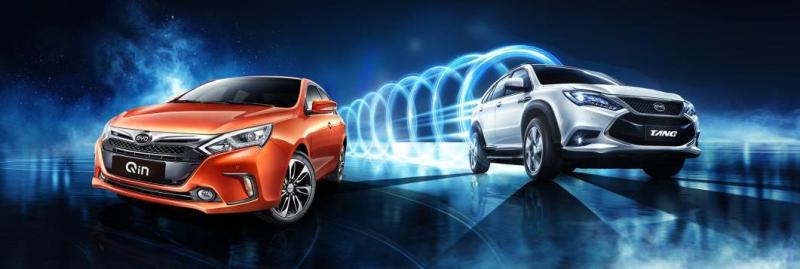Fonte: BYD
2 dicembre 2015. Mentre il 2015 si avvicina alla sua fine, BYD diventa il più grande EV Maker in tutto il mondo.
In una classifica globale EV appena pubblicata, BYD Company Ltd. È al primo posto nelle vendite nel mese di ottobre – per il sesto mese consecutivo da maggio – con un totale di 6.099 veicoli elettrici venduti. Tuttavia, la classifica di ottobre rappresenta un vero e proprio spartiacque per la società, perché per la prima volta BYD è anche al primo posto nelle vendite complessive durante tutto l’anno – per un totale di 43,069 unità vendute EV, un aumento 222% rispetto allo stesso periodo dell’anno scorso – superando tutti i leader americani, giapponesi ed europei fino ad oggi.
 Le prestazioni eccezionali di BYD nel 2015 – in cui l’azienda è salito dalla posizione 7 alla fine del 2014 alla prima posizione in soli 10 mesi – è il risultato di una strategia accuratamente studiata e progettata combinata con la percezione del mercato. Dopo il successo del lancio del suo primo modello PHEV – la berlina Qin – che ha posto l’azienda sulla mappa degli EV da passeggeri ed ha caratterizzato un aumento delle vendite mese su mese dalla fine del 2013, BYD ha continuato a lanciare un altro modello PHEV, questa volta la snella SUV Tang, nel giugno 2015, come
Le prestazioni eccezionali di BYD nel 2015 – in cui l’azienda è salito dalla posizione 7 alla fine del 2014 alla prima posizione in soli 10 mesi – è il risultato di una strategia accuratamente studiata e progettata combinata con la percezione del mercato. Dopo il successo del lancio del suo primo modello PHEV – la berlina Qin – che ha posto l’azienda sulla mappa degli EV da passeggeri ed ha caratterizzato un aumento delle vendite mese su mese dalla fine del 2013, BYD ha continuato a lanciare un altro modello PHEV, questa volta la snella SUV Tang, nel giugno 2015, come  parte di una completa gamma PHEV con la seguente strategia 542 performance della società – in cui “5” è il tempo del veicolo a potere raggiungere i 100km/h in meno di 5 secondi, “4”, che significa quattro ruote motrici e “2” per la sua efficienza di combustibile di 100 chilometri con meno di 2 litri di benzina – che ha conquistato il gusto dei consumatori.
parte di una completa gamma PHEV con la seguente strategia 542 performance della società – in cui “5” è il tempo del veicolo a potere raggiungere i 100km/h in meno di 5 secondi, “4”, che significa quattro ruote motrici e “2” per la sua efficienza di combustibile di 100 chilometri con meno di 2 litri di benzina – che ha conquistato il gusto dei consumatori.
I prossimi veicoli della gamma sono I SUV Song e Yuan, che sicuramente aggiungerà importanti numeri alla società.
L’aumento dei veicoli elettrici viene insieme con l’aumento della industria automobilistica cinese e quello di BYD Company Ltd. La strategia EV dell’azienda non si limita a semplici autovetture, nonostante la sua prestazione eccezionale in questa categoria. La strategia 7 + 4 incarna le sue ambizioni per il futuro di quello che viene chiamato in Cina “veicoli di nuova energia”, in cui le autovetture sarebbero solo parte di un quadro molto più grande. L’azienda mira a elettrizzare tutti i mezzi possibili di trasporto, e ha percorso un lungo cammino verso la realizzazione di una simile impresa: il “7” sta per i veicoli convenzionali, che comprende autobus, pullman, taxi, auto private, camion logistica urbana, camion servizi igienico-sanitari e camion costruzioni (betoniere); e “4” sta per specifici fuoristrada ambienti: magazzino, miniere, aeroporti, porti. L’aumento della costruzione dei PHEV della società è stato tanto poco appariscente quanto massiccia è stata la sua presenza nel trasporto pubblico elettrico in tutto il mondo. A partire dal 2010 i suoi autobus e taxi completamente elettrici (BEV) sono operativi in oltre 160 città in 40 paesi.
In English
As 2015 Nears its End, BYD Becomes Biggest EV Maker Worldwide
Source: BYD
December 2nd, 2015. In a just-released global EV ranking, BYD Company Ltd. ranked first in sales in October – for the sixth consecutive month since May – with a total of 6,099 EV units sold. However, the October ranking represents a true watershed for the company because for the first time BYD also ranks first in accumulated sales throughout the year – with a total of 43,069 EV units sold, a 222% surge as compared to the same period last year – overcoming all American, Japanese and European leaders to date.
BYD’s outstanding performance in 2015 – in which the company climbed from the 7th position in late 2014 to the first position in just 10 months – is the result of a carefully studied and planned strategy combined with savvy market perception. After the successful launch of its first “dynastic” PHEV model – the sedan Qin – that placed the company on the passenger EV map and featured increased sales month-on-month since late 2013, BYD went on to launch yet another PHEV model, this time the streamlined SUV Tang in June 2015, as part of a complete PHEV lineup following the company’s 542 performance strategy – in which “5” means the vehicle’s power to reach 100km/h in under 5 seconds, “4” meaning four-wheel drive, and “2” for its fuel efficiency of 100km with less than 2 liters of gasoline – that has conquered the taste of consumers. Next in line are the SUVs Song and Yuan, which will most definitely add to the company’s mushrooming numbers.
The rise of EVs comes together with the rise of the Chinese Auto Industry and that of BYD Company Ltd. The company’s EV strategy is not limited to mere passenger vehicles, in spite of its outstanding performance in this category. Its 7+4 strategy epitomizes its ambitions for the future of what is called in China “new energy vehicles”, where passenger cars would be just part of a much bigger picture. The company aims at electrifying all possible means of transportation, and it has gone a long way towards accomplishing such feat: the “7” stands for major conventional vehicles, comprising bus, coach, taxi, private car, urban logistic truck, sanitation truck and construction truck (concrete mixer); and “4” stands for specific off-road environments: warehouse, mining, airports, ports. The company’s rise in PHEVs has been as inconspicuous as its massive presence in Electrified Public Transportation worldwide. Starting in 2010, now its fully electric (BEV) buses and taxis are running in over 160 cities in 40 countries.
no images were found




Commenta per primo